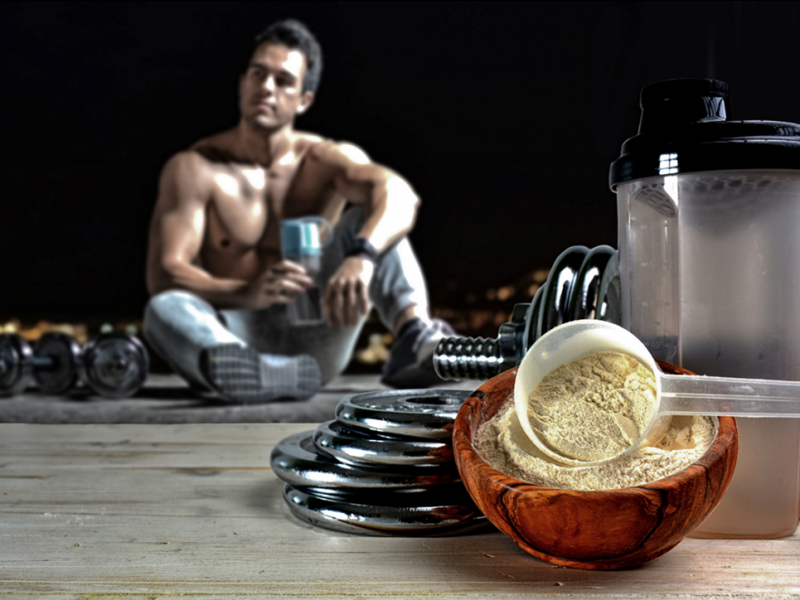Sergio Molina, MASmusculo Fit coach explains to us how we could use the squat to work and better strengthen the quadriceps .
If you have been training for a long time, you should already understand that if you want to develop a muscular and strong physique, you would have to design the leg days in the most effective way possible and in this instance, the quadriceps are very relevant.
Fortunately, you can learn not only to train your legs, but to do it in a way that helps you gain size, strength, and muscle.
Why the squat is essential
The squat is the ultimate exercise for the lower body; It is the undisputed king of leg exercises and to have powerful quadriceps , this is a must in your leg routine.
It’s a complete and tough workout for the athlete, not only does it give you that adrenaline rush, but it does trigger some major DOMS (late-onset muscle soreness), but the results will prove it’s worth it.
The squat is best done inside a squat rack for safety reasons, and we won’t be talking about how to develop it here, but to make it more effective.
Everyone knows that front squats are more “ quadriceps dominant” than back squats and therefore work those huge muscles that are front in the legs and those that give a spectacular figure.
Physics counts when training
Now, we could analyze the biomechanics of the different squat techniques, observing how torque is generated and manipulated in the hip, knee, and lower back by using a static mathematical model.
Imagine that you are holding a 5 kg dumbbell in front of you at shoulder height… do you feel the weight trying to pull your arm down?
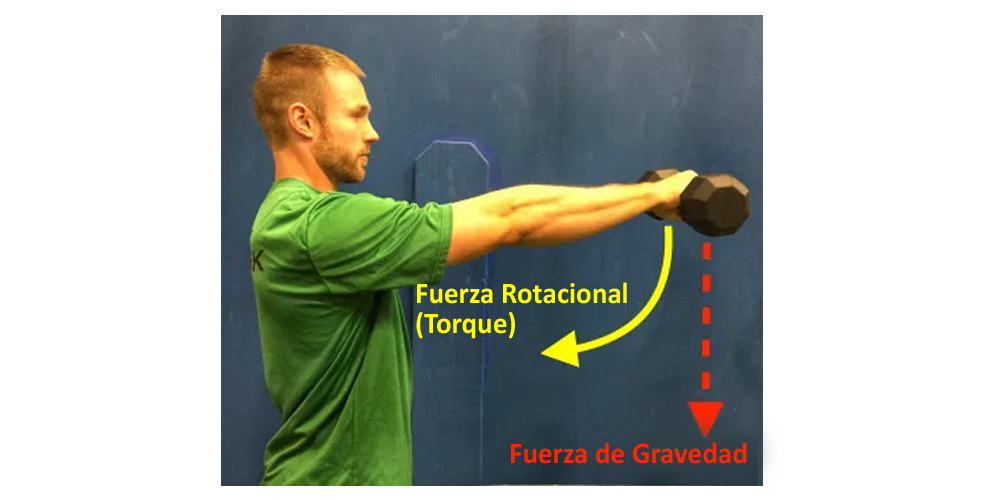
What you feel is the force of gravity that always pulls down; well, as gravity pulls on the dumbbell, it causes a rotational force on the shoulder joint.
This force is called torque and we talk about it because the shoulder muscles must be activated to overcome this force and prevent the weight from moving.
The distance from the force of gravity and the point of rotation (the shoulder joint in this case) is called the lever arm.
Like a wrench that turns a bolt, the longer the lever arm, the more rotational force (torque) can be applied to the joint.
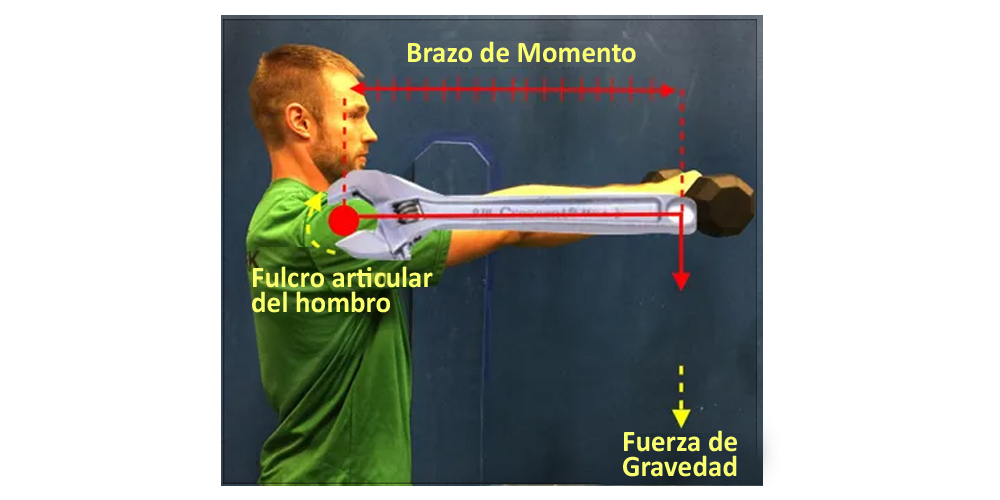
The “moment arm” is used to describe the distance from the point of force (dumbbell) to the point of rotation (axis of the joint in this case) at a 90 degree angle.
When the arm is at 90 degrees, the lever arm is the same length as the moment arm.
- Now imagine that someone tied a rope around the same 5 kg dumbbell and tied it to their elbow; the result: “now it would be much easier to hold your arm in front of you”.
- This is because the length of the lever arm decreased, which meant that the shoulder required less force (torque) to keep the arm extended.
Does it make sense? …
The squat and physics: how are they related?
If we take a snapshot of a squat in the parallel position, we can calculate the amount of torque that is generated in each joint complex (hips, knees and lower back).
As we mentioned earlier, gravity always pulls down and during the squat it is often represented as a vertical line drawn through the center of the bar; This vertical line then crosses the body and divides the thigh.
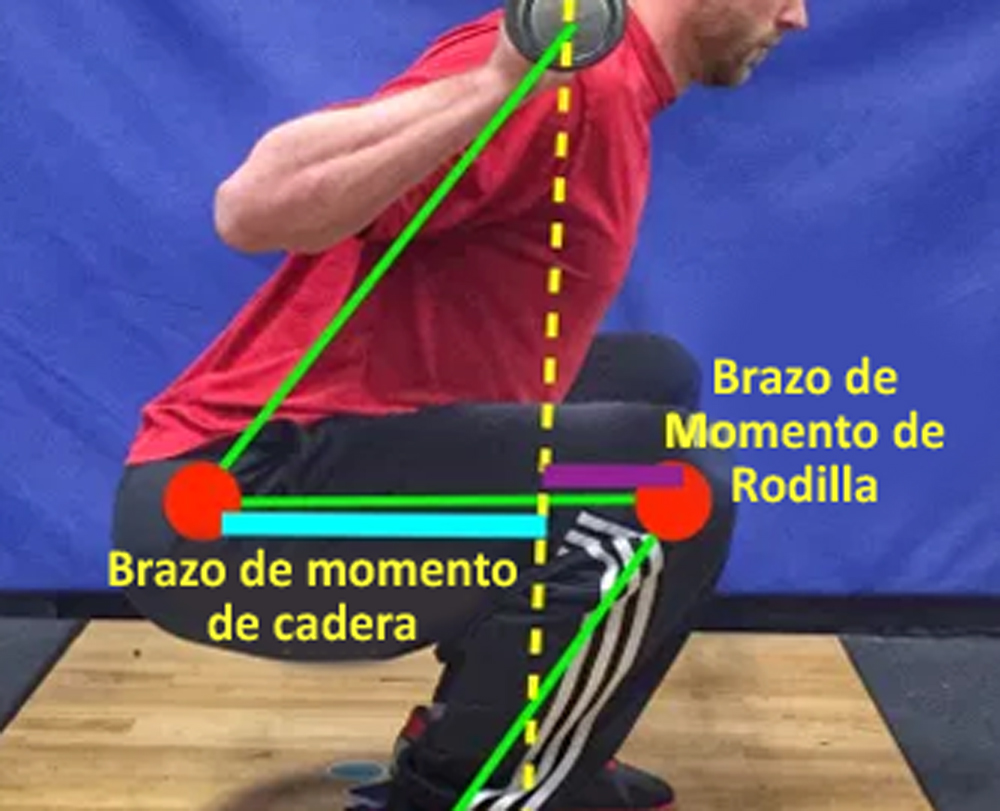
The distance from this vertical line to the center of a joint becomes a lever (like a wrench that turns the bolt).
Often times, sports scientists will analyze squatting in a parallel squat position (hip crease in line with the knee).
The longer the lever arm is in this position, the more torque will be generated at that joint during the squat.
Front Squat vs Back Squat
When we looked at the different squat techniques, we found some interesting things.
- The back squat has a longer lever arm compared to the front squat, making it more efficient for lifting heavy weights (this is known as leverage). Mechanically, our bodies can squat heavier when the lever arm is longer at the hips.
- The front squat (with the trunk position more upright) creates a longer lever arm at the knee and therefore applies more torque to the knee joint.
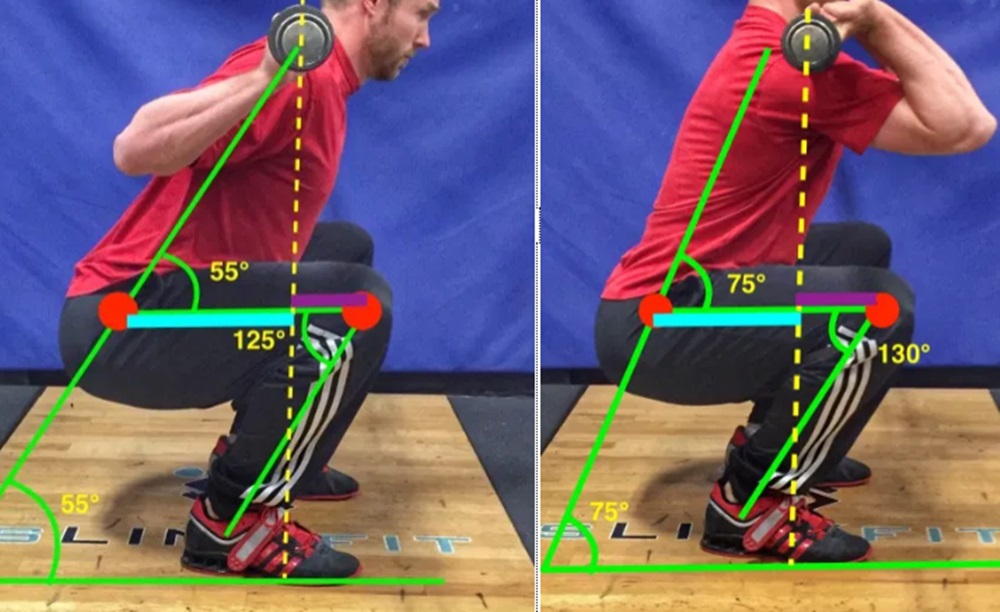
Many will take these findings and claim that the back squat prioritizes the hip compared to the front squat where the quadriceps is prioritized.
They will also think that because there is more torque in the hips or knees in a certain squat technique, the muscles around that specific joint must work harder to overcome that force.
Unfortunately, this is not how the body works during multi-joint movements like the squat.
Anatomy: fiction or reality?
Much of the misunderstandings on this topic stem from the way we learned about the body in the first place… our anatomy textbooks….
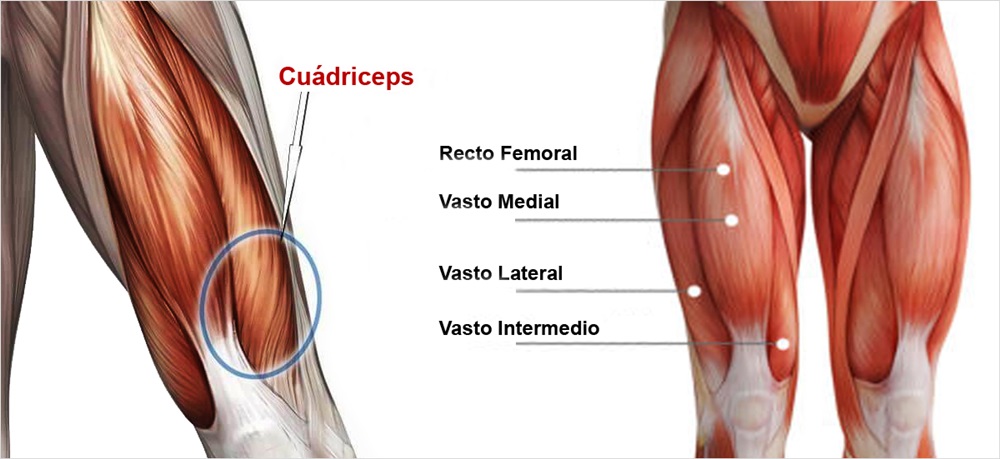
Think about how muscles and their function are described in the literature;
- We have muscles that cross only one joint (called monoarticular) and muscles that cross two joints (called biarticular).
- In the front of your thigh, for example, you have the vastus medialis and the vastus lateralis.
- Both muscles cross only the knee joint and are therefore considered single-joint muscles that extend the knee when contracted.
- The rectus femoris is another quadriceps muscle that helps with knee extension, however, because it also crosses the hip joint (making it a biarticular muscle) , is also able to flex the hip joint when it contracts.
On the opposite side of the thigh we find the hamstrings and the gluteus maximus; The gluteus maximus is one of the most powerful muscles in the entire body; It is a monoarticular muscle since it only crosses the hip joint.
Semitendinosis (one of the hamstrings) is a bi-articulated muscle that crosses the hip and knee joints.
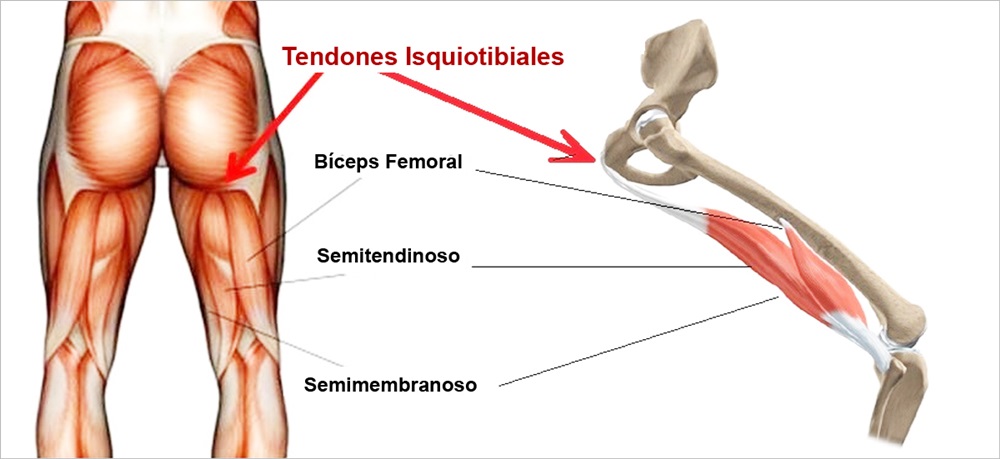
Therefore, this muscle can be used to extend the hip or flex the knee, making it a direct antagonist of the quadriceps .
According to “your anatomy textbook,” if the quads are contracting hard to try to extend the knee, the hamstrings must relax to allow movement to occur. Sound familiar?
Quadriceps : which squat?
In the early 1900s there was a biomechanic named W.P. Lombard who investigated how the body actually works, outside of our textbook understanding (1).
The “paradox” you described occurs when muscles that technically should oppose each other are active during certain movements. For example, when we squat, the hamstrings and quadriceps are activated.
If the hamstrings (which flex the knee) are activated at the same time as the quadriceps (which extend the knee), shouldn’t the body just freeze and not move?
So, any conclusions about what about the squat ?:
- The buttocks can indirectly extend the knee joint.
- The quadriceps can indirectly extend the hip joint
Basically, the glutes and the vastus muscles of the quadriceps function as generators of force and work, while the hamstring and rectus muscles distribute torque and power between the two joints .

We can now use this knowledge to help answer the question “are the quads activated more during a front squat than a back squat?”
- While there is more torque placed on the knee joint during a front squat, the body does NOT activate the quads more to overcome this force.
- The quadriceps are already “on” during the squat to lift the weight; instead, the body redistributes power from the hips to the knees to help the body complete the lift.
Therefore, the quadriceps are no longer activated in a front squat, it all depends on how you activate them.
Remember, whenever you train hard, you require a nutritional boost.
Quadriceps : what is the paradigm?
During the rise of a squat, the ideal is that the chest and the hips rise at the same time; This keeps the bar centered over the midfoot, which means that the body is in balance and capable of producing efficient power.
However, as athletes become fatigued from squatting (near the end of a high-rep training session or when trying to reach near maximum weight), they often lose their ability to balance and maintain a perfect coordination, allowing your chest to drop forward.
The excessive forward lean of the trunk causes the hips to rise faster than the chest in the rise of the squat, which lengthens the hamstrings.
Because the biarticulated hamstrings are now elongated, the body loses the ability to transfer force from the quadriceps to assist the glutes in hip extension.
Dr. Gregory Myer and Dr. Brad Schoenfeld have explained this failure as a problem with suboptimal motor recruitment patterns (that is, the body’s ability to activate the correct muscles at the right time to maintain technique) (2).
What this means is that this is not caused solely by a lack of strength in the quadriceps , but rather due to problems in coordination and motor control leading to a disruption, which leads to Lombard’s paradox (1900).
Here the conclusion would be that, instead of taking into account the weakness of the quadriceps , the most probable cause of this technical failure is the ability to “turn on” the glutes at the right time. to fatigue.
Quadriceps: how to work them?
While a squat may seem more “hip dominant” or ” quadriceps dominant”, the squat does not exclusively train the quads , hamstrings, or buttocks.
All the muscles in the lower body are activated together to extend the hips and knees, regardless of what the squat looks like or how much torque is applied to the joints.
The solution proposed by Sergio Molina is the use of a security bar with a handle ( security bar ), making the quadriceps work greater because there is not as much hip flexion, even improving comfort for the wrist.
In the case of a front squat, the forces change and therefore the demand of the muscle changes, with a much more vertical trunk, making the quadriceps involvement greater.
The point is, bilateral hand-held movements allow athletes to express intention and strength development that cannot be achieved with heavy standard unilateral work.
This leads to improved adaptations and, ultimately, maximum performance, when using a manual support thanks to the handles on the bar.
Quadriceps : a more efficient work?
Using a seat bar with a handle is the remedy for several of the problems discussed above.
In history, Fred Hatfield originally popularized it, and the squat of the same name “Hatfield Squat” has appeared in some circles, including bodybuilding.
Dr. Fred Hatfield aka Dr. Squat was the first man at the age of 45 to set a squat world record by lifting 1014 pounds in the 100kg weight class, the first person to ever Squat over 1,000 pounds.
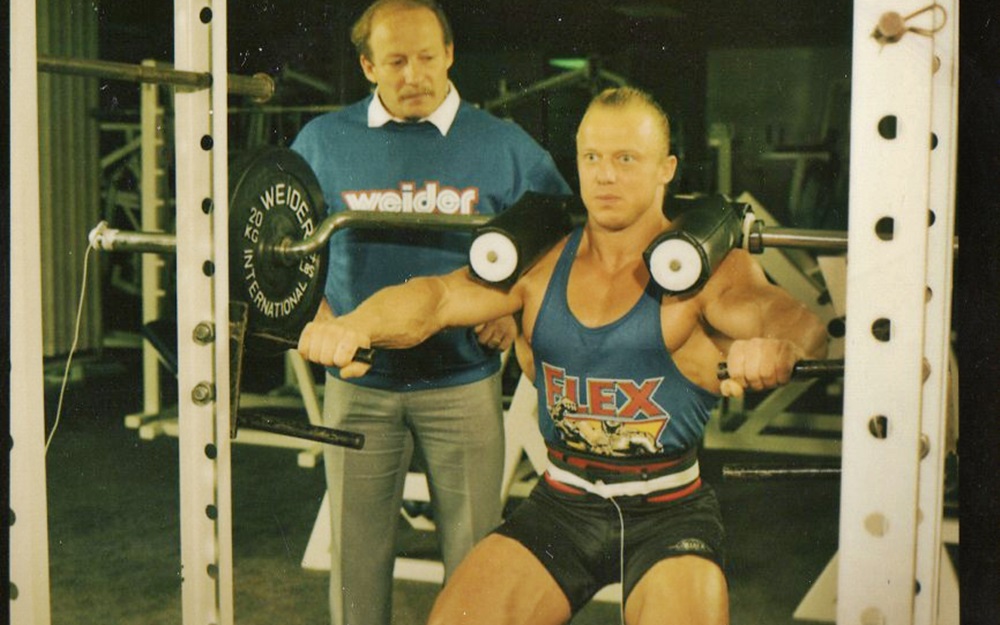
Logically, when the “sticking point” is reached, your hands can be used to help you get past it (3).
This unique feature allows you to work with heavier weights in the ranges of motion where you are strongest and provides assistance when you are weakest, working closer to your maximum effort throughout the entire range of motion.
For everyone, the goal is to work as close to maximum effort; In Hatfield’s case, he liked to use the movement to add volume at higher intensities than could be achieved with conventional squats.
Hatfield also preferred the weight distribution offered by the seat bar.
- The conventional squat places the weight behind you, about 10 cm behind the midline of your body; This can cause you to lean forward for balance.
- With the safety bar with a handle, the weight is distributed directly in line with the midline of your body, inhibiting the need to lean forward and putting much more effort on the quadriceps.

